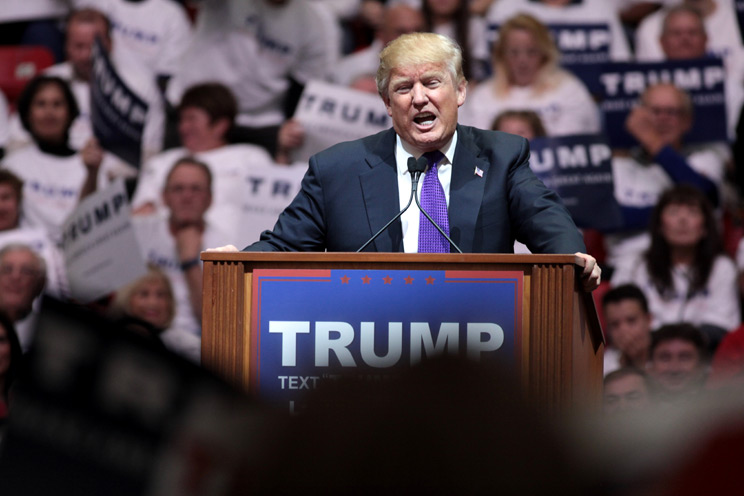Although I am no supporter of Donald Trump (or Mrs. Clinton for that matter), I am curious to know what lay behind Mr. Trump’s success in the key ‘rust belt’ states. I suspect part of it is due to his effective communication style. Trump had been called many things in the media: a sexist, a misogynist, a jackass, a rightwing protectionist and an American catastrophe. Some columnists have gone so far as to call him a clown and buffoon. Other columnists more recently cast a shadow on the electoral results. So how did he win?
On reading and listening to his speeches recently I found an extraordinary mastery of some aspects of classical rhetoric and audience identification. He wasn’t trying to persuade the liberal intelligentsia of the east and west coasts or the grandees of the Republican Party. His objective was simply to appeal to ordinary Republican voters and to win over the discontented democratic blue collar vote. His rhetoric helped these particular audiences to identify with his messages and feel the future advantages accruing to them. This is what, I believe, partly helped him to win their confidence.

Rhetoric, in the classical Aristotelian sense, is the art of persuasion. Cicero, the great Roman orator, described it as ‘speech designed to persuade’. In a nutshell, rhetoric is designed to grab the attention of an audience, keep it, and then make the message stick. We do all this by the use of rhetorical figures (over 200 of them) and the mixture of ethos, pathos and logos. We shall look at the following excerpt for just two of the rhetorical tools he used frequently, and his effective use of pathos (emotional appeal):
“We are going to make our country so strong and so powerful
and we are going to make our country great again
and it’s going to be a beautiful beautiful thing to watch so beautiful…”
In this example Trump appeals to his audiences’ hearts with language and tonality, and they can identify with his message. He uses not only repetition but an exaggeration of reality which in rhetoric is termed a hyperbole (an impression produced by an obvious exaggeration). Coupled with this was an effective use of pathos which helped, along with the softening of his voice, and placing an emphasis on the word ‘beautiful’. This worked because he directed it to his particular audiences and not to the Clintonian east and west coast elites. Look at the following use of pretence, one at the end of the sentence and the other at the beginning, to ‘deny’ a statement (apophasis):
- “I was going to say ‘dummy’ Bush; I won’t say it. I won’t say it,”
- “I refuse to call Megyn Kelly a bimbo, because that would not be politically correct,”
Using to great effect verbal and non-verbal language, Trump sounded more sincere to his intended audiences; especially to the discontented democrats. To others, who were not his intended audience, all of this reeked of popularism and insincerity. They identified him as somewhat vulgar and below the dignity of the White House. But whatever view we may take, Donald Trump got his communication style right in relation to his intended audiences. It wasn’t his concern what the intelligentsia or the grandees of the Republican Party thought of him.
Political (deliberate) rhetoric, according to Aristotle, addresses topics such as war and peace, national defence, trade and legislation in order to access what is harmful and beneficial for the audience. In other words, it builds on some facts, spoken with great vivacity, to persuade the audience of what advantages and disadvantages will accrue to them in the future. In looking at Trump’s speeches he certainly was effective.


Interesting reply and thanks
Trump masterfully used hyperbolic rhetoric. Certainly that’s one way he tapped into populist angst. That said, he also made fantastical promises, which, while common to politicians, he took to a whole new level. It will be interesting to see whether he delivers, and whether republicans will hold him accountable if he doesn’t (both are doubtful). Here are just some of his promises:
Repeal Obamacare
Build a long giant wall along the US/Mexico boarder and make Mexico pay for its development
Send 11 illegal immigrants home
Lower corporate taxes to 15%
Increase economic growth in the US to at least 4%
Defeat ISIS…fast
Drain the swamp (whatever that means)
Overturn Roe vs Wade
Put Hillary in jail “lock her up”
Renegotiate NAFTA
Bring back manufacturing jobs
Bring back the coal industry
Ban Muslims from immigrating to the US (until they can be stringently vetted)
Institute term limits for congress
Bring back waterboarding and “enhanced interrogation” techniques
Make Japan and other countries pay for the defense support they receive from the US
End diplomatic relationships with Cuba and close the US embassy there
Make America great again!
So, yes, rhetoric, but with a heavy dollop of overpromising. Finally, he also defaulted to a well-documented right-wing trope; ginning up racism. It is no accident at all that he drew so many “alt-right” (i.e., racist) voters. (http://www.theatlantic.com/politics/archive/2016/11/richard-spencer-speech-npi/508379/).
In the Nixon era it as known as the “Southern Strategy”. Here is a candid interview with John Ehrlichman, chief advisor to Nixon, discussing it in an interview with Harper’s magazine published after his death: http://www.cnn.com/2016/03/23/politics/john-ehrlichman-richard-nixon-drug-war-blacks-hippie/
Here is a 42-minute audio tape where Lee Atwater, strategist and advisor to Ronald Reagan and George H.W. Bush, explains the strategy in surprisingly raw and candid terms. https://www.thenation.com/article/exclusive-lee-atwaters-infamous-1981-interview-southern-strategy/